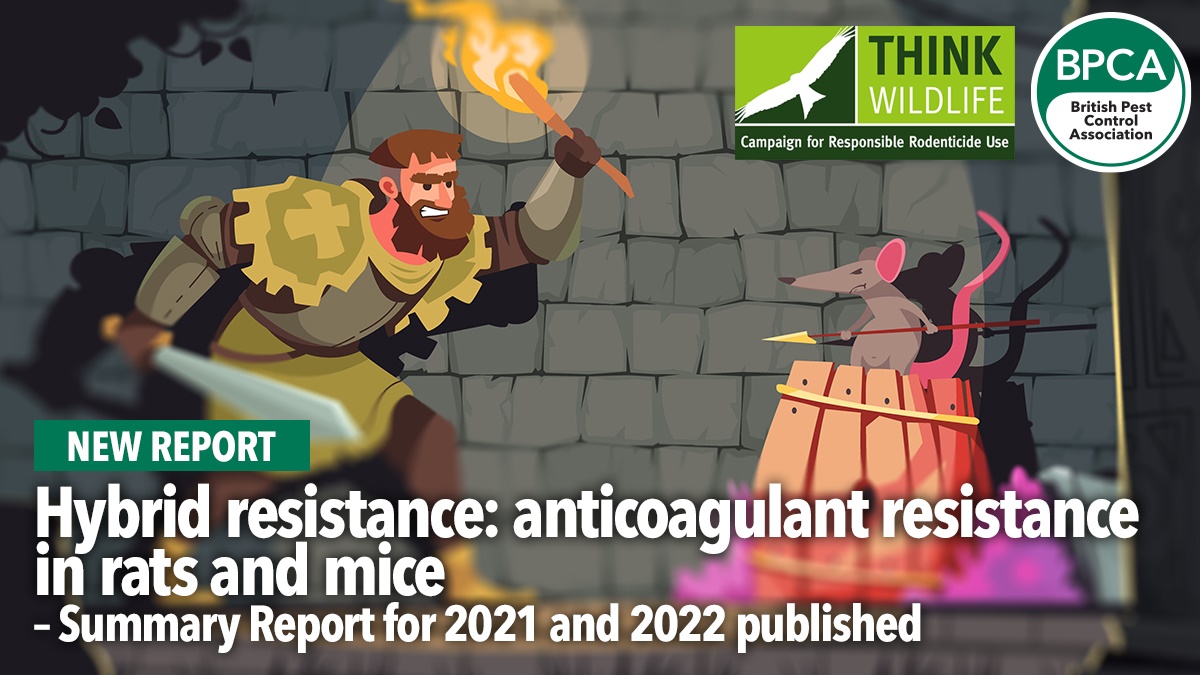PRESS RELEASE
Campaign for Responsible Rodenticide Use (CRRU) UK has published a new summary of anticoagulant resistance data for rats and mice in the UK, including 2021 and 2022 data.
The report includes details on hybrid resistance (when a rat or mouse has developed two mutations).

Summary of the report
This summary is taken from the CRRU report VPU/22/002. It is available to read in full at thinkwildlife.org/downloads
Sample data
During the period 2009 and 2022, in which these DNA resistance surveys have been conducted (first at the University of Reading and now at the Animal and Plant Health Agency) a total of 489 Norway rat and 129 house mouse tissue samples have been examined, with DNA extracted from them and sequenced.
Among these samples, it was found that 77.9% of rats and 94.6% of mice carried one or more single nucleotide polymorphisms (SNPs), which are known significantly to affect the efficacy of anticoagulant rodenticides.
These results may not reflect the true frequency of resistance in the two species, however, because samples are generally sent by those experiencing difficulties in obtaining control of rodent infestations with anticoagulants.
Norway rats
Norway rats in the UK carry five different resistance mutations known to have adverse consequences for the effectiveness of anticoagulants (Y128Q, Y139S, L120Q, Y139F and Y139C), and house mice carry three such mutations (L128S, Y139C and the ‘spretus introgression’).
The latter was found for the first time in 2022 in three mice from Hertfordshire.
Large numbers of samples permit the geographical distribution of resistance in Norway rats in the UK to be determined.
- L128Q is largely restricted to Scotland and the north of England
- Y139S is found mainly in Wales, on the Anglo-Welsh border and in an expanding focus in North Yorkshire
- L120Q is very widespread across central southern England
- Y139F is found mainly in Kent, East Sussex and Greater London
- Y139C is ubiquitous, with no distinctive geographical central focus.
However, particularly with regard to the three most severe Norway rat mutations, namely L120Q, Y139F and Y139C, outlying resistant foci occur with an increasing frequency almost anywhere in England, either disseminated by natural rodent movement or by human transportation systems.
Although there remains evidence of an area of remnant susceptibility in some counties of the Midlands and on the English north-east coast, these areas are now increasingly infiltrated by resistance.
House mice
...all UK house mouse infestations should be assumed to carry resistance, and treatments should be conducted against them accordingly.
Fewer house mouse samples are obtained, but these show that anticoagulant resistance is also widespread in this species.
In this respect, it is the position of the Rodenticide Resistance Action Group (RRAG) that all UK house mouse infestations should be assumed to carry resistance, and treatments should be conducted against them accordingly.
Hybrid resistance
As foci of resistance in both rats and mice spread and overlap, there is an increasing occurrence of ‘hybrid resistance’, in which individuals carry more than one different resistance SNP.
We know little of the consequences of hybrid resistance on rodenticide efficacy, but evidence is emerging from studies of house mice in France that hybrid resistance may render rodents less susceptible to anticoagulants than those that carry only one SNP.
Recommendations
The maps of Norway rat and house mouse resistance foci presented in this report permit reasonably fine-grained advice to be given to rodenticide users about which interventions to use and which to avoid, following recommendations of RRAG.
Implementation of that advice would:
- Facilitate faster and more effective rodent control for the better protection of human and animal health
- Prevent the increasing severity and spread of anticoagulant resistance, and of great importance to the objectives of CRRU and rodenticide stewardship
- Reduce unnecessary and ineffective emissions of anticoagulants into wildlife and the wider environment.
The information presented here should be the subject of a concerted effort of dissemination, in an attempt to prevent the purchase of certain rodenticides in areas where there is compelling evidence that their use would be ineffective.
FULL REPORT
The full report is available to read in full at thinkwildlife.org/downloads

Source: Online